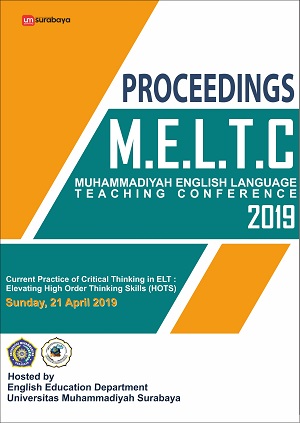The Analysis Of Students’ Critical Thinking In Writing Hortatory Exposition Text
Abstrak
This study which entitles the analysis of students’ critical thinking in writing hortatory exposition text focuses on elaborating the critical thinking of the second social graders students in SMAN 1 Tarik. This study also aims to find out the factors influencing the students’ critical thinking. This study employs descriptive qualitative as the research design. The data which is used to be analyzed is from the students’ writing hortatory exposition text. The result of this study showed that 43% of students are categorized to the developing level. While 33% students are categorized to beginning level and 23% students are in unacceptable level. The limited critical thinking standard showed in the students’ writing such as clarity, relevancy, and logic. The factors of critical thinking also can be found in this study. The interview results show that the students which have better level of critical thinking, they have reading habit and update the recent information. Other finding of this study is external closures can influence the critical thinking but in this case, the researcher didn’t find any students which participate in any seminars or public discourse which can develop the way of students thinking. In short, having much knowledge about recent issue helps the students to be more critical. Therefore students need to develop their critical thinking through some factors that influence the critical thinking.
Key words: Argument, Critical thinking, Hortatory exposition text, Writing
Referensi
Ary, D., Jacobs, L. C., & Sorensen, C. (2010). Introduction to Research in Education. Canada: Wadsworth Cengage Learning.
Bassham, G., Irwin, W., Nardone, H., & Wallace, J. M. (2011). CRITICAL THINKING : A student's Introduction. New York: McGraw-Hill.
Browne, M. N., & Keeley, S. M. (2007). Asking The Right Qestion . Pearson Prentice Hall.
Creswell, J. W. (2014). Research Design. USA: SAGE Publication.
Darman, R. U., & Saun, S. (2014). Teaching Writing Hortatory Exposition Text By Using Team Asissted Individualization (TAI) Strategy To Senior High School Students. Padang: FBS State University of Padang.
Dr. Rahmad Husein, M., & Dr. Anni Holila Pulungan, M. (2016). SUMBER BELAJAR PENUNJANG PLPG 2016:HORTATORY EXPOSITION. KEMENTERIAN PENDIDIKAN DAN KEBUDAYAAN DIREKTORAT JENDERAL GURU DAN TENAGA KEPENDIDIKAN.
Dr. Richard Paul,Dr. Linda Elder. (2008). The Miniature Guide to Critical Thinking. Foundation for Critical Thinking Press.
Hardegree, G. M. (2009). Symbolic Logic: A First Course (Older Edition). Mcgraw-Hill College.
Hasanah, N. (2015). The Realtionship Between Critical Thinking Skill and Argumentative Writing Skill. Jakarta: Syarif Hidayatullah State Islamic University.
Lambert, V. A., & Lambert, C. E. (2012). Qualitative Descriptive Research: An Acceptable Design. Pacific Rim International Journal Of Nursing Research, Vol.16 No.4 Page 255.
Longmans Green and CO LTD. (1956). Taxonomy of Educational Objectives. Canada: David Mckay Company.
Miles, M. B., Huberman, A. M., & Saldaña, J. (1994). Qualitative Data Analysis : An Expanded Source Book. SAGE.
Opp-Beckman, L., & Westerfield, K. (2006). Saudi English Supervisor Program: Shaping the Way Forward. Retrieved March 20, 2017, from http://oelp.uoregon.edu/shaping. html
Rachmawati, Y. (2015). An Anlaysis of Critical Thinking Aspects in Students' Discussion Text. Jakarta: Indonesia University of Education.
Rhodes, T. L. (2010). m Assessing Outcomes and Improving Achievement: Tips and tools for. Retrieved March 20, 2017, from The Association of American Colleges and Universities: http://www.sfasu.edu/acadaffairs/images/FINAL_CRITICAL_THINKING_RUBRIC.pdf
Salmon, M. (2007). Introduction to Logic and Critical Thinking, 5th Edition. Thomson Wadworth.
Salmon, M. (2013). Introduction to Logic and Critical Thinking, 6th Edition. Thomson Wadworth.
Sugianto, A. (2014). The Realtionship Between Critical Thinking Bility and Writing Ability. Jakarta: Syarif Hidayatullah State Islamic University.






